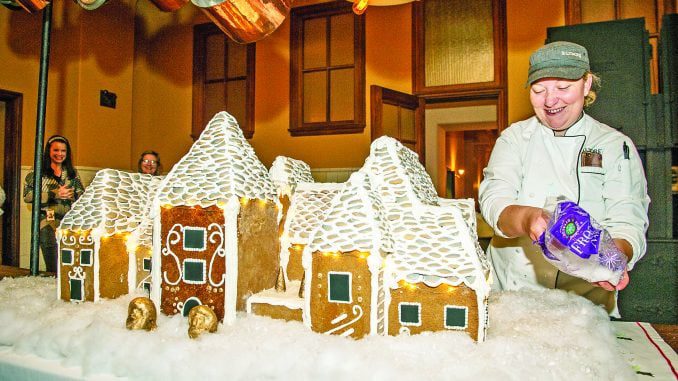
ASHEVILLE, N.C. — Here’s what you’ll need to make a gingerbread model of Biltmore House: gingerbread, of course. Royal icing. Homemade vanilla wafers. Silver luster. Modeling chocolate. Gold dust. And a little vodka.
The biggest challenge? Not surprisingly, the roof, says Deerpark pastry chef Julie Scheibel, who led her 10-person team on the six-week project to create the gingerbread house now on display in the Biltmore House kitchen.
“The roof took about a week, solid, with at least one person working on it eight hours a day,” Scheibel said. It’s a laborious process that begins with baking hand-crafted vanilla wafers. The cooled cookies are then sliced in half with a serrated knife before being adhered, one by one, to the roof with a sugary mortar mixture.
Oh, and each tasty tile is hand-dusted with silver luster, a fine-grained culinary powder used to add pizzazz to baked goods. Or gingerbread houses.
Unlike the creations at the Grove Park Inn, which have to be edible through and through, the Biltmore gingerbread is so large it needs a wooden skeleton. So a reusable framework was created some years ago by the estate’s engineering team, precisely scaling down the dimensions of the actual building.
The skeleton is affixed to a wooden platform. Once the inner frame is cleaned up and ready to go, the construction order isn’t that different from building a real house: walls first, then roof (starting at the bottom and moving upward), lights, decorations.
The walls are all actual gingerbread, minus the leavening, baked a little longer than you would your cookies. “I just try to make sure it’s super sturdy,” Scheibel says, “since it’s going to be here for about two months.”
Most of the roof was constructed by Scheibel and pastry cook Deron Noel.
“He did the majority of the work this year,” Scheibel says. “The two of us did the roof together. He installed the little LED lights that you see. And he did most of the decorations.”
Some of Noel’s work on the house involved sitting at a computer, printing photos of Biltmore House to determine how to shape and where to place the doors and windows, and looking up other confectionary creations for ideas on the swirls, dots and dashes of royal icing that are the finishing touches — “to see what looks the nicest,” he said.
He would discuss his design ideas with Scheibel and then start piping the house’s white highlights directly onto the walls.
The details change year after year, depending on the chefs working on it, so the pastry team would appreciate it if Biltmore visitors could pause a moment in the kitchen to admire all the particulars.
Those two lions flanking the front door, for example: That’s where the vodka comes in.
Schiebel hand-sculpted the lions from modeling chocolate. “It’s just chocolate and corn syrup,” she says. “You melt down your chocolate and add corn syrup and it makes it like modeling clay” when it cools. “And then it dries hard.” Once hardened, the lions were painted with gold — the real stuff. “It’s gold dust mixed with vodka,” she notes.
While this is Noel’s second time on the team, it’s Schiebel’s first year as team leader, having joined Biltmore more recently.
It’s far from her first gingerbread house, however. At her previous gig, at Georgia’s Sea Island resort, she worked on elaborate creations every Christmas, inspired by fantasies that included “Alice in Wonderland,” ”Frozen” and Whoville from “How the Grinch Stole Christmas.”
Her advice for home cooks determined to make a gingerbread construction, at least one that favors endurance over edibility: Overcook your gingerbread (and leave out the leavening). “And make sure when you’re making your royal icing that it’s really thick. If you don’t start with a really thick product, like paste, then it will never stick fully when you’re gluing your pieces together.”
As for transporting the house: It helps if it’s fastened to a solid wooden platform (hidden in its final location with a layer of cotton snow). A team of four drove the house from Deerpark before dawn the morning after the tree raising in the Banquet Hall, then wheeled it carefully through Biltmore House’s basement to the kitchen, precariously sitting atop the cooks’ equivalent of a library cart.
Along with Scheibel and Noel for the delivery were pastry demi chef Megan Moorhead and pastry cook Kayla Breedlove, and they had the house set up and surrounded by snow within just 20 minutes of their arrival. They were assisted by members of Biltmore’s floral team and supervised by Lizzie Borchers, Biltmore’s floral manager, the person in charge of all the estate’s decorations.
“I love it,” Borchers says of this year’s gingerbread house. She’s especially happy with Schiebel’s addition of tiny LED lights along the roof line, since illumination “is something we’ve been oomphing up this year” throughout the estate.
The gingerbread house provides a touch of Christmas in the kitchen, where the addition of other Christmas decorations wouldn’t make much sense.
“We’re not going to put a tree down here or deck it out,” Borchers says. “The style and what fits down here and in the servants’ rooms, the servants’ dining room, should be different from what you see upstairs. It should reflect the space.”
Within the home’s historical context, as it would have appeared at Christmas when occupied by the Vanderbilt family, Borchers imagines the gingerbread house sits in the kitchen “being worked on by the staff before it goes up to the Banquet Hall, maybe for a party.”
Borchers says this year’s gingerbread house is “different from anything we’ve done before. It’s kind of great to see how many different ways we can make a gingerbread house out of Biltmore.”
Don’t believe her? Lead decorator Noel has simple advice for those passing through the kitchen and encountering his work. Pause long enough to make sure you “don’t miss a thing.”

